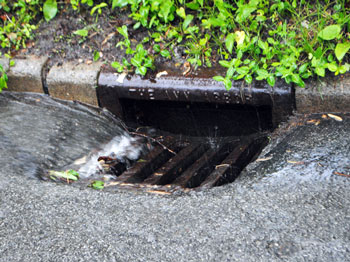County Gets Info on Flooding, Shares Options
A meeting last week at Lawton Elementary School, in southwest Ann Arbor, fell the day before the one-year anniversary of significant overland flooding in the neighborhood. The flooding resulted from heavy rains last year on March 15, 2012. Last week’s meeting followed an earlier one held on Jan. 29, 2013.
The meetings are part of a study of the Upper Malletts Creek watershed, being conducted by the office of the Washtenaw County water resources commissioner under an agreement with the city of Ann Arbor. The year-long study is supposed to culminate in a final report due to the Ann Arbor city council in February 2014. Water resources commissioner Evan Pratt was on hand at the meeting, along with other members of the project team.
In response to direction from a citizens advisory group that’s been formed for the project, the team used the March 14 meeting to introduce residents to the basic toolkit for stormwater management techniques. The general stormwater management practices described at the meeting – without trying to analyze which solutions might be appropriate for specific locations in the area – ranged from increasing the number of catch basins in streets to the construction of underground detention facilities.
At least 60 residents attended the meeting, and seemed generally receptive to the idea that some money might actually be spent on infrastructure projects to reduce flooding in their neighborhood: “If you want me to sign up for you breaking up my street and putting [stormwater management infrastructure] in there, just give me a consent form and I will sign it tonight!”
The project team is also still in a phase of gathering information about specific experiences that residents have had with past flooding problems. And the same technology platform – an online mapping tool – can be used by residents for logging future flooding events. For help in using a smart-phone app, one attendee volunteered her grandson “for rent” to other residents. Members of the project team also indicated they welcomed information submitted in any format – including letters, face-to-face conversation and phone calls.
But it was a missing follow-up phone call – expected from one resident who’d attended the first meeting on Jan. 29 – that indicated some continuing frustration about the city’s footing drain disconnection (FDD) program. The frustrated resident’s experience had been that after an FDD program sump pump was installed in his basement, he’d started having problems with a wet basement – problems he hadn’t experienced before. Project manager Harry Sheehan, with the county water resources commissioner’s office, extended an apology for the missed communication and an offer to arrange a site visit.
The FDD program removes a building’s footing drain connection to the sanitary sewer system and redirects that stormwater flow to the system designed to handle it – the stormwater system. The FDD program, which has been somewhat controversial, is not the focus of the Upper Malletts Creek study. But residents got an assurance that the additional volume of rainwater that goes into the stormwater system – as a result of the FDD program – would be accounted for in all the modeling that’s done as part of this study. [Full Story]




